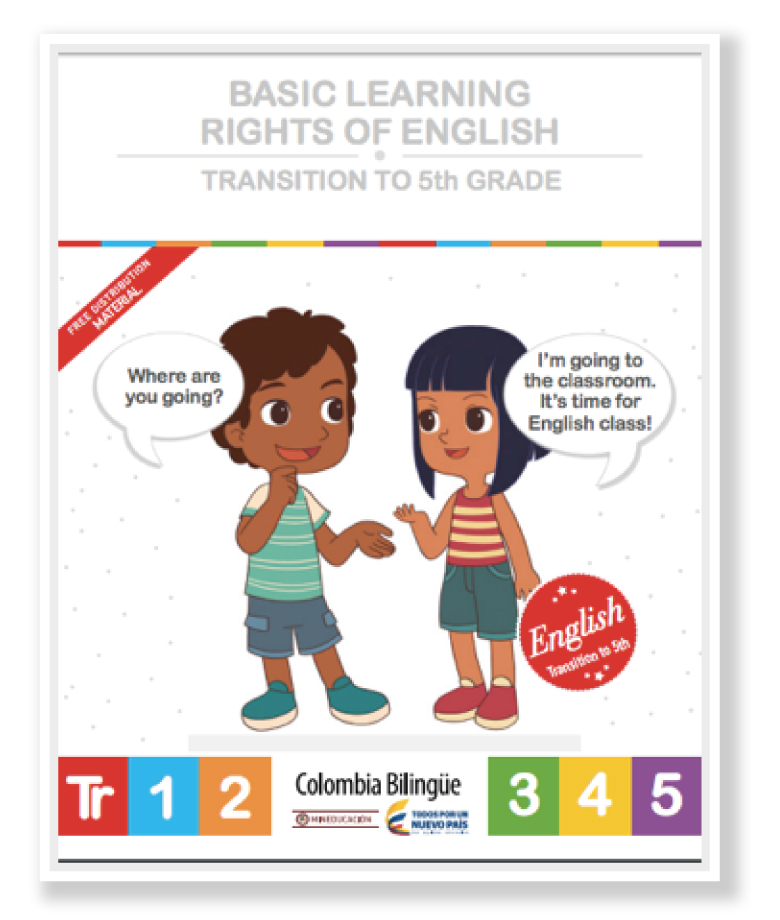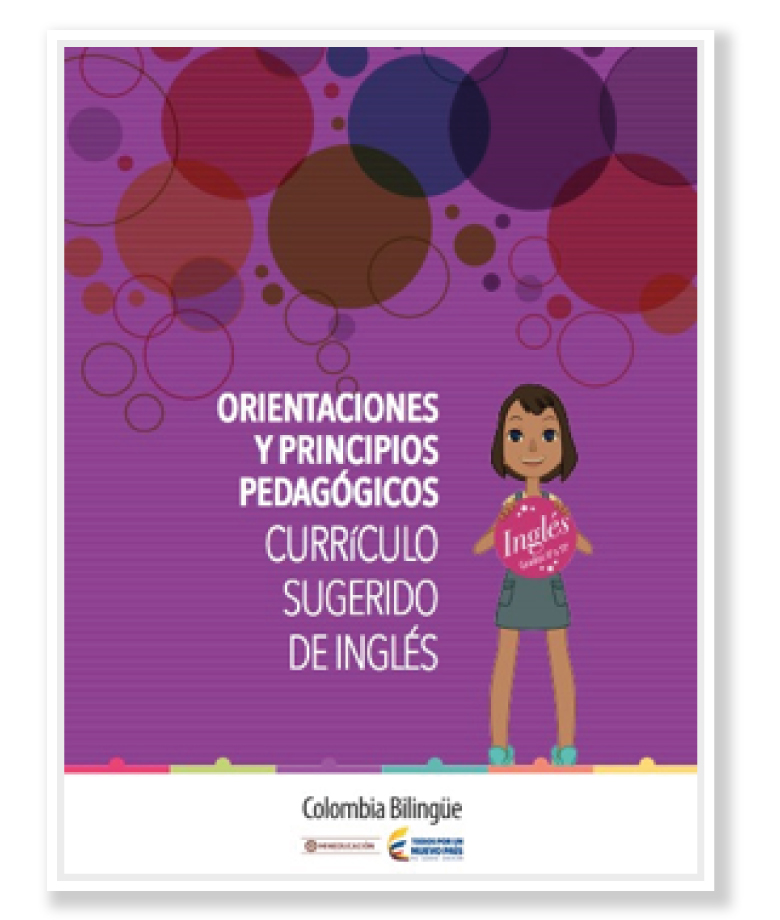“El Currículo Sugerido de Inglés: herramienta fundamental para contribuir a la calidad y equidad educativa de todos los niños, niñas y jóvenes en el país”.
El diseño de un currículo, en cualquier entorno educativo, supone un proceso complejo de toma de decisiones que deben partir del conocimiento profundo del contexto y de una fundamentación conceptual que dé fuerza y validez al mismo.
De conformidad con lo establecido en la Ley General de Educación de Colombia, se exhorta a las instituciones educativas a “considerar criterios, como planes de estudio, programas, metodologías y procesos que contribuyen a la formación integral y a la construcción de la identidad cultural nacional, regional y local, incluyendo también los recursos humanos, académicos y físicos para poner en práctica las políticas y llevar a cabo el proyecto educativo institucional” (Colombia, Ley 115 de 1994, Art. 76).
El diseño curricular requiere, por una parte, el análisis del contexto, sus problemáticas, condiciones y requerimientos y, por otra, la formulación de una serie de principios pedagógicos, metodológicos y de evaluación que se articulen con un mapa de objetivos, metas, indicadores y contenidos sugeridos. Algunos autores lo consideran como un “todo en sí mismo”, un sistema, con componentes que se relacionan entre sí y con el contexto mayor en que se implementa de manera simultánea y abierta (Morin, 2004).
Generalmente, este concepto responde a las siguientes preguntas:
- ¿Qué temas incluir?
- ¿Cuándo y cómo abordar la enseñanza-aprendizaje?
- ¿Cómo abordar esta enseñanza-aprendizaje?
- ¿Qué, cómo y cuándo evaluar el aprendizaje?
Un diseño curricular pertinente debe partir de un diagnóstico exhaustivo de tipo cualitativo y del análisis de necesidades que se traduce en una serie de características, ejes y propósitos curriculares. Estos elementos se constituyen en fundamentos y constructos teóricos que consideren las características de sus actores y la diversidad demográfica, social y educativa propias del contexto al que se dirige el currículo.
 De acuerdo con lo anterior, el Ministerio de Educación Nacional, comprometido con el mejoramiento de la comunicación en inglés en todo el ciclo escolar promueve el programa Colombia Bilingüe y, en alianza con la Universidad del Norte, en 2015 y 2016 diseñó el Currículo Sugerido de Inglés desde el grado transición al grado 11.
De acuerdo con lo anterior, el Ministerio de Educación Nacional, comprometido con el mejoramiento de la comunicación en inglés en todo el ciclo escolar promueve el programa Colombia Bilingüe y, en alianza con la Universidad del Norte, en 2015 y 2016 diseñó el Currículo Sugerido de Inglés desde el grado transición al grado 11.
La implementación del currículo sugerido de Inglés en los grados 6º a 11 de las instituciones educativas oficiales inició en el año 2016, y durante 2017 se comenzó a implementar en los grados de transición a quinto de primaria. Esta herramienta es fundamental para asegurar la calidad y equidad educativa de todos los niños, niñas y jóvenes en el país.
El Currículo Sugerido de Inglés describe saberes y habilidades que los estudiantes deben adquirir y desarrollar en el área de Inglés, se estructuró guardando coherencia con los Estándares Básicos de Competencias en Lenguas Extranjeras: Inglés, establecidos por el Ministerio de Educación Nacional (Guía N.o 22, MEN, 2006) y el Marco Común Europeo de Referencia para las Lenguas.
El diseño de este currículo contó con los aportes de expertos académicos e investigadores en el área de la enseñanza y del aprendizaje del inglés, quienes se encargaron de su estructuración y validación con un grupo amplio y variado de docentes e instituciones educativas, tanto del sector oficial como no oficial, representativas de las diferentes regiones del país.
El Currículo Sugerido de Inglés, y cada uno de sus componentes, se encuentra a disposición de la comunidad educativa en formato digital, tanto en inglés como en español, en el ‘edusitio’ del programa Colombia Bilingüe: http://aprende.colombiaaprende.edu.co/colombiabilingue/94013, donde se puede descargar el siguiente material:
- Cartilla Derechos Básicos de Aprendizaje (DBA) de Inglés
- Cartilla Orientaciones y Principios Pedagógicos (para docentes y para Secretarías de Educación e instituciones educativas)
- Cartilla Mallas de Aprendizaje
- Guía Práctica para la Implementación del Currículo
- Afiches (Alcance y secuencia y DBA)
 Como estrategia para acercar a los docentes de transición y de primaria al currículo de inglés, el programa Colombia Bilingüe diseñó un plan de formación dirigido a 29 Secretarías de Educación, en el cual participaron más de 950 docentes. El plan estableció dos momentos: uno de socialización y otro de implementación. En el primer momento, se presentan los componentes de la propuesta curricular y se brindan estrategias para su uso y apropiación; mientras tanto en el segundo se enfatiza en la estrategia de implementación del currículo, para lo cual se trabaja detenidamente con la Guía de Implementación.
Como estrategia para acercar a los docentes de transición y de primaria al currículo de inglés, el programa Colombia Bilingüe diseñó un plan de formación dirigido a 29 Secretarías de Educación, en el cual participaron más de 950 docentes. El plan estableció dos momentos: uno de socialización y otro de implementación. En el primer momento, se presentan los componentes de la propuesta curricular y se brindan estrategias para su uso y apropiación; mientras tanto en el segundo se enfatiza en la estrategia de implementación del currículo, para lo cual se trabaja detenidamente con la Guía de Implementación.
Una vez terminada la estrategia de “Formación en el uso y apropiación del Currículo Sugerido de Inglés”, se espera que las instituciones educativas oficiales lleven a cabo su propio proceso de implementación y validación de la nueva propuesta curricular. Esto les permitirá a las comunidades educativas contar con una estructura académica sólida para fortalecer lo s procesos de enseñanza y aprendizaje del inglés, de una manera integral.
s procesos de enseñanza y aprendizaje del inglés, de una manera integral.
El programa Colombia Bilingüe reconoce la importancia de empezar a impactar e intervenir en la educación básica primaria, ya que esta se constituye en la base de formación de las futuras generaciones. De esta manera, el programa busca lograr que al menos el 8% de los estudiantes del sector oficial evaluados tenga el nivel preintermedio B1 o superior de inglés, según el Marco Común Europeo de Referencia y cumplir con uno de los pilares establecidos desde el Plan de Desarrollo 2014-2018 del Gobierno Nacional: “Colombia será un país conformado por ciudadanos con capacidad de convivir en paz, respetando los derechos humanos, la diversidad poblacional, las normas y las instituciones”. RM
“The English Suggested Curriculum: an important tool for contributing to higher academic quality and equity for all children and youngsters in the country.”
In accordance to the Colombian General Education Bill, the educational institutions are encouraged to “consider criteria, such as syllabi, programs, methodologies and processes that contribute to the comprehensive education constructing a local, regional and national identity that includes human, academic and physical resources to implement the policies and institutional educational project”. (Colombia. Bill 115 of 1994, Art. 76).
Curricular design needs an analysis of the context, the problems, conditions, and requirements. It also needs to formulate a series of pedagogical, methodological, and assessment principles articulating a map with the objectives, goals, indicators and suggested content. Some authors think of it as an “everything within itself” and a system with components relating to one another and to the greater context where it will be implemented openly and simultaneously (Morin, 2004).
- This concept, generally, answers the following questions ¿What topics to include?
- ¿When to approach teaching-learning?
- ¿How to approach this teaching-learning?
- ¿What, how, and when to assess learning?
A pertinent curricular design must start from an extensive qualitative diagnosis and analysis of the needs being interpreted as a series of curricular features and purposes. These elements are based on theoretical ideas and is constructed considering the features of their participants as well as the demographic, social, and educational diversity of the context where the curriculum is aimed at.
According to The Ministry of National Education, committed to the improvement of communication in English for the whole school cycle, promotes the “Colombia Bilingüe” Program, and in partnership with the Universidad del Norte, during 2015 and 2016, designed the English Suggested Curriculum from Kindergarten to 11th grade.
The implementation of the English Suggested Curriculum (ESC) in the grades of 6th to 11th in official educational institutions started in the year of 2016. For the grades Kindergarten to 5th, it started in 2017. This tool is vital for assuring higher academic quality and equity for all children and youngsters in the country.
The ESC describes knowledge and skills students must acquire and develop in the English Subject. It was structured keeping close coherence to the Basic Competence Standards in Foreign Languages: English, established by the Ministry of National Education (Guide N. 22, MNE, 2006) and the Common European Framework of Reference for Languages
The design of this curriculum had the input of academic experts and researchers in the field of English teaching and learning. They were in charge of structuring and validating this curriculum with a wide and varied group of institutions and teachers from both private and public sectors and that were representative in the different regions of the country.
The ESC, and each of its components can be acquired on-line easily by the educational community, either in Spanish or English, from the “edu site” of the Colombia Bilingüe program:
http://aprende.colombiaaprende.edu.co/colombiabilingue/94013, here you can download the following material:
- English Basic Learning Rights (BLRs) booklet
- Pedagogical principles and guidelines booklet (for teachers and Secretaries of Education and Educational Institutions).
- Learning Syllabus booklet
- Practical guide for Curriculum Implementation
- Posters (Scope and Sequence and BLRs)
In order to prepare Kindergarten and Elementary School teachers for the English Curriculum, the Colombia Bilingüe Program designed a training plan for 29 Secretaries of Education, where more than 950 teachers took part. The plan had two moments: first, socialization; second, implementation. During the first moment, the components of the curriculum were presented and strategies for its implementation were given. The second moment stresses the curriculum implementation strategy working closely with the Implementation Guide.
Once the implementation of “ESC Use and Implementation Training” is finished it is expected that the public educational institutions will carry out their own implementation and validation processes of the new curriculum. This will allow the educational communities to have a solid academic structure to reinforce the English learning and teaching processes comprehensively.
Colombia Bilingüe program acknowledges the importance of creating an impact and an intervention in the Elementary Education, being that this the foundation of the coming generations. Thus, the program seeks to have at least 8% of the students in the public sector at a pre-intermediate level of B1 or above, according to the CEFR, complying with the pillars established by the Development Plan of 2014-1018 of the National Government: “Colombia shall be a country comprised by citizens with the capacity of living peacefully, respecting the human rights, demographic diversity, laws, regulations, and the institutions”. RM





